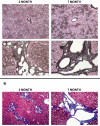Renin-angiotensin system activation in congenital hepatic fibrosis in the PCK rat model of autosomal recessive polycystic kidney disease
- PMID: 20400910
- PMCID: PMC4241057
- DOI: 10.1097/MPG.0b013e3181cc80e4
Renin-angiotensin system activation in congenital hepatic fibrosis in the PCK rat model of autosomal recessive polycystic kidney disease
Abstract
Objectives: Congenital hepatic fibrosis (CHF) is an important cause of morbidity and mortality in patients with autosomal recessive polycystic kidney disease (ARPKD). The pathogenesis of CHF remains undefined. Several recent studies suggest that the renin-angiotensin system (RAS) is an important mediator of progressive hepatic fibrosis through activation of profibrotic mediators, such as transforming growth factor-beta (TGF-beta). RAS activation has not previously been studied in patients with CHF or in animal models. The aim of the present study was to characterize RAS expression during the course of CHF in the PCK rat.
Materials and methods: Studies were conducted in the PCK rat, an orthologous ARPKD/CHF model, and age-matched normal control Sprague-Dawley rats. Expression of the RAS components, renin, angiotensinogen, angiotensin-converting enzyme (ACE), and angiotensin II type 1 receptor (AT1R), as well as the profibrotic mediator TGF-beta, was examined in cystic PCK and control rat livers at 2, 4, and 6 months of age by quantitative real-time polymerase chain reaction (qRT-PCR). Angiotensin II (ANG II) was examined by immunohistochemistry (IHC). Fibrosis was assessed by IHC using reticulin staining and Masson trichrome. Collagen content was determined by hydroxyproline analysis.
Results: Progressive fibrosis and increased hepatic collagen content occurred in PCK rats with age. In 4- and 6-month-old PCK rat livers, ACE gene expression was markedly increased, 8- and 17-fold, respectively, compared with age-matched control livers. Expression of the other RAS components, renin, angiotensinogen, and AT1R were not significantly different. IHC demonstrated prominent ANG II protein expression in periportal regions in PCK rats. In contrast, no expression was noted in control livers. TGF-beta expression was also increased in PCK rat livers with progressive disease.
Conclusions: The present study demonstrates, for the first time, RAS upregulation in an orthologous rat ARPKD/CHF model. Increases in ACE and ANG II, as well as the downstream target, the profibrotic mediator TGF-beta, suggest that RAS activation may be an important mediator of CHF disease progression. The findings also suggest that treatment with RAS inhibitors, specifically ACE inhibitors or AT1R blockers, could be therapeutic in slowing disease progression in CHF.
Figures




Similar articles
-
The renin-angiotensin system and hypertension in autosomal recessive polycystic kidney disease.Pediatr Nephrol. 2010 Dec;25(12):2449-57. doi: 10.1007/s00467-010-1621-z. Epub 2010 Aug 27. Pediatr Nephrol. 2010. PMID: 20798958
-
Telmisartan ameliorates fibrocystic liver disease in an orthologous rat model of human autosomal recessive polycystic kidney disease.PLoS One. 2013 Dec 6;8(12):e81480. doi: 10.1371/journal.pone.0081480. eCollection 2013. PLoS One. 2013. PMID: 24324698 Free PMC article.
-
Characterization of the Renin-Angiotensin System in Aged Cavernosal Tissue and its Role in Penile Fibrosis.J Sex Med. 2020 Nov;17(11):2129-2140. doi: 10.1016/j.jsxm.2020.08.008. Epub 2020 Sep 15. J Sex Med. 2020. PMID: 32943375
-
Liver disease and the renin-angiotensin system: recent discoveries and clinical implications.J Gastroenterol Hepatol. 2008 Sep;23(9):1327-38. doi: 10.1111/j.1440-1746.2008.05461.x. Epub 2008 Jun 28. J Gastroenterol Hepatol. 2008. PMID: 18557800 Free PMC article. Review.
-
Role of the renin-angiotensin system in hepatic fibrosis and portal hypertension.Korean J Intern Med. 2018 May;33(3):453-461. doi: 10.3904/kjim.2017.317. Epub 2018 Feb 21. Korean J Intern Med. 2018. PMID: 29462546 Free PMC article. Review.
Cited by
-
Angiotensinogen gene transcription in pulmonary fibrosis.Int J Pept. 2012;2012:875910. doi: 10.1155/2012/875910. Epub 2012 Feb 20. Int J Pept. 2012. PMID: 22500179 Free PMC article.
-
Role of genetic modifiers in an orthologous rat model of ARPKD.Physiol Genomics. 2012 Aug 1;44(15):741-53. doi: 10.1152/physiolgenomics.00187.2011. Epub 2012 Jun 5. Physiol Genomics. 2012. PMID: 22669842 Free PMC article.
-
Inhibition of Mast Cell Degranulation With Cromolyn Sodium Exhibits Organ-Specific Effects in Polycystic Kidney (PCK) Rats.Int J Toxicol. 2018 Jul/Aug;37(4):308-326. doi: 10.1177/1091581818777754. Epub 2018 Jun 3. Int J Toxicol. 2018. PMID: 29862868 Free PMC article.
-
Is angiotensin-(3-4) (Val-Tyr), the shortest angiotensin II-derived peptide, opening new vistas on the renin-angiotensin system?J Renin Angiotensin Aldosterone Syst. 2017 Jan;18(1):1470320316689338. doi: 10.1177/1470320316689338. J Renin Angiotensin Aldosterone Syst. 2017. PMID: 28097883 Free PMC article. Review.
-
Predictors of progression in autosomal dominant and autosomal recessive polycystic kidney disease.Pediatr Nephrol. 2021 Sep;36(9):2639-2658. doi: 10.1007/s00467-020-04869-w. Epub 2021 Jan 21. Pediatr Nephrol. 2021. PMID: 33474686 Free PMC article. Review.
References
-
- Guay-Woodford LM, Desmond RA. Autosomal recessive polycystic kidney disease: the clinical experience in North America. Pediatrics. 2003;111:1072–80. - PubMed
-
- Kamath BM, Piccoli DA. Heritable disorders of the bile ducts. Gastroenterol Clin North Am. 2003;32:857–75. vi. - PubMed
-
- Dell KM, Avner ED. GeneClinics: Clinical Genetic Information Resource [database online] Copyright, University of Washington; Seattle: 2001. Autosomal recessive polycystic kidney disease. Available at http://www.geneclinics.org. Initial posting July 2001, updated 2008.
-
- Shneider BL, Magid MS. Liver disease in autosomal recessive polycystic kidney disease. Pediatr Transplant. 2005;9:634–9. - PubMed
-
- Davis ID, Ho M, Hupertz V, Avner ED. Survival of childhood polycystic kidney disease following renal transplantation: the impact of advanced hepatobiliary disease. Pediatr Transplant. 2003;7:364–9. - PubMed
Publication types
MeSH terms
Substances
Grants and funding
LinkOut - more resources
Full Text Sources
Other Literature Sources
Medical
Miscellaneous

